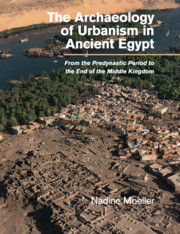 The Archaeology of Urbanism in Ancient Egypt
The Archaeology of Urbanism in Ancient Egypt Book contents
- The Archaeology of Urbanism in Ancient EgyptFrom the Predynastic Period to the End of the Middle Kingdom
- The Archaeology of Urbanism in Ancient Egypt
- Copyright page
- Dedication
- Contents
- Figures
- Preface
- Introduction
- 1 Ancient Urbanism and the Case of Egypt
- 2 Current and Past Studies of Egyptian Settlements
- 3 The Environmental Setting
- 4 The Origins of Urban Society
- 5 The Settlements of the Old Kingdom
- 6 The Layout of Old Kingdom Houses
- 7 The Development of Towns during the End of the Old Kingdom and the First Intermediate Period (ca. 2200–2050 BCE)
- 8 The Middle Kingdom: Town Planning and Internal Colonization at Its Height
- Further discussions and archaeological details relating to Chapter 8
- 9 House Layouts in the Middle Kingdom
- 10 Final Conclusions
- Notes
- Index
- References
5 - The Settlements of the Old Kingdom
Published online by Cambridge University Press: 05 April 2016
- The Archaeology of Urbanism in Ancient EgyptFrom the Predynastic Period to the End of the Middle Kingdom
- The Archaeology of Urbanism in Ancient Egypt
- Copyright page
- Dedication
- Contents
- Figures
- Preface
- Introduction
- 1 Ancient Urbanism and the Case of Egypt
- 2 Current and Past Studies of Egyptian Settlements
- 3 The Environmental Setting
- 4 The Origins of Urban Society
- 5 The Settlements of the Old Kingdom
- 6 The Layout of Old Kingdom Houses
- 7 The Development of Towns during the End of the Old Kingdom and the First Intermediate Period (ca. 2200–2050 BCE)
- 8 The Middle Kingdom: Town Planning and Internal Colonization at Its Height
- Further discussions and archaeological details relating to Chapter 8
- 9 House Layouts in the Middle Kingdom
- 10 Final Conclusions
- Notes
- Index
- References
- Type
- Chapter
- Information
- The Archaeology of Urbanism in Ancient EgyptFrom the Predynastic Period to the End of the Middle Kingdom, pp. 113 - 191Publisher: Cambridge University PressPrint publication year: 2016
References
- 1
- Cited by


